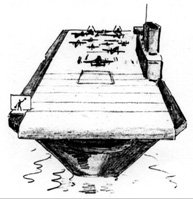
As planes landed they were moved forward immediately. Planes in need of servicing and repair were taken down to the hangar deck on huge elevators. When planes were all landed they were moved aft to be ready for takeoff.
About 180-200 feet length available at the stern for
landing.

As planes landed they were moved forward immediately. Planes in need of servicing and
repair were taken down to the hangar deck on huge elevators. When planes were all landed
they were moved aft to be ready for takeoff.
 |
Landing on a small area of flight deck (often heaving and
dipping 30 feet or more) is a tricky business. To the pilot coming in for a landing, the
most important man aboard was the Landing Signals Officer. Standing on a platform aft, and
silhouetted against a white canvas backdrop, the L.S.O. watched the approach carefully. If
the plane was coming in at correct height, speed and angle he waved it in with his paddles. If not, he signaled "Too high," "Too Fast," "Right a little," etc. If the approach was too bad, both paddles crossed over head signaled a wave-off, "No good - try again." A paddle tapped on the deck meant: Your landing hook is not down. |

To survive the jarring forces of carrier landings, carrier aircraft have to be built more
strongly than land-based planes. To stop quickly, carrier planes have retractable hooks
called arrestor hooks. These hooks are caught by arrestor wires stretched across the deck
(laid flat when not in use). These wires run out under tension when the hook is caught,
stopping the plane in a few feet.

Plane coming in, wheels, flaps and hook down, engine throttled back.